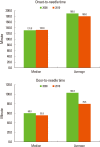Stroke Statistics in Korea: Part II Stroke Awareness and Acute Stroke Care, A Report from the Korean Stroke Society and Clinical Research Center For Stroke
- PMID: 24324942
- PMCID: PMC3779666
- DOI: 10.5853/jos.2013.15.2.67
Stroke Statistics in Korea: Part II Stroke Awareness and Acute Stroke Care, A Report from the Korean Stroke Society and Clinical Research Center For Stroke
Abstract
The aim of the current Part II of Stroke Statistics in Korea is to summarize nationally representative data on public awareness, pre-hospital delay, thrombolysis, and quality of acute stroke care in a single document. The public's knowledge of stroke definition, risk factors, warning signs, and act on stroke generally remains low. According to studies using open-ended questions, the correct definition of stroke was recognized in less than 50%, hypertension as a stroke risk factor in less than 50%, and other well-defined risk factors in less than 20%. Among stroke warning signs, sudden paresis or numbness was best appreciated, with recognition rates ranging in 36.9-73.7%, but other warning signs including speech disturbance were underappreciated. In addition, less than one third of subjects in a representative population survey were aware of thrombolysis and had knowledge of the appropriate act on stroke, calling emergency medical services (EMS). Despite EMS being an essential element in the stroke chain of survival and outcome improvement, EMS protocols for field stroke diagnosis and prehospital notification for potential stroke patients are not well established. According to the Assessment for Quality of Acute Stroke Care, the median onset-to-door time for patients arriving at the emergency room was 4 hours (mean, 17.3 hours) in 2010, which was not reduced compared to 2005. In contrast, the median door-to-needle time for intravenous tissue plasminogen activator (IV-TPA) treatment was 55.5 minutes (mean, 79.5 minutes) in 2010, shorter than the median time of 60.0 minutes (mean, 102.8 minutes) in 2008. Of patients with acute ischemic stroke, 7.9% were treated with IV-TPA in 2010, an increase from the 4.6% in 2005. Particularly, IV-TPA use for eligible patients substantially increased, from 21.7% in 2005 to 74.0% in 2010. The proportion of hospitals equipped with a stroke unit has increased from 1.1% in 2005 to 19.4% in 2010. Performance, as measured by quality indicators, has steadily improved since 2005, and the performance rates for most indicators were greater than 90% in 2010 except for early rehabilitation consideration (89.4%) and IV-TPA use for eligible patients (74.0%). In summary, the current report indicates a substantial improvement in in-hospital acute stroke care, but also emphasizes the need for enhancing public awareness and integrating the prehospital EMS system into acute stroke management. This report would be a valuable resource for understanding the current status and implementing initiatives to further improve public awareness of stroke and acute stroke care in Korea.
Keywords: Acute stroke; Care; Public awareness; Statistics; Stroke.
Conflict of interest statement
The authors have no financial conflicts of interest.
Figures















References
-
- Korean Statistical Information Service (KOSIS) Population Projections and Summary Indicator for Korea (Population items) [Accessed July 18, 2012]. http://kosis.kr/eng/database/database_001000.jsp?listid=A&subtitle=Popul....
-
- Organization for Economic Cooperation and Development. OECD Economic Surveys: Korea 2010. OECD Web site. [Accessed April 2011]. http://www.oecd.org/dataoecd/14/34/45432048.pdf.
-
- Bae HJ. Epidemiology of Stroke: 2006 Update. Korean J Stroke. 2007;9:5–10.
Publication types
LinkOut - more resources
Full Text Sources
Other Literature Sources

